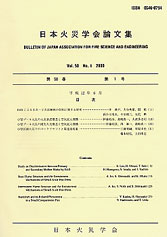
- Issue 3 Pages 35-
- Issue 2 Pages 21-
- Issue 1 Pages 1-
- |<
- <
- 1
- >
- >|
-
Katsuhiro OKAMOTO, Hideyuki FUJIWARA, Hiroki YAMASAKI, Toshikazu ICHIK ...2023 Volume 73 Issue 1 Pages 1-12
Published: April 25, 2023
Released on J-STAGE: April 26, 2024
JOURNAL FREE ACCESSGasoline, which is used as a fuel for automobiles, is often used as a combustion accelerator in arson cases because of the high flammability, portability, availability, and low cost. Since the volatility of gasoline is high, a large amount of gasoline vapor is generated from the gasoline liquid surface. The gasoline vapor spreads around and mixes with air forming a combustible mixture. When gasoline is spilled on the floor, the vapor diffuses away from the liquid surface with the passage of time, and the flammable area can extend upwards. Therefore, when an arson fire with gasoline occurs, it is necessary to clarify the amount of spilled gasoline, the ignition source and ignition location, and the specific fire hazard that occurs after ignition in order to prove the facts of the crime. On the other hand, since gasoline is a multi-component liquid fuel, the component composition changes with the progress of evaporation. This makes it difficult to predict the exact evaporative diffusion behavior. In this study, we developed a simulation tool for one-dimensional diffusion of gasoline in the height direction under various conditions in which gasoline was spilled indoors, using the previously reported gasoline evaporative diffusion model. This tool can automatically calculate gasoline vapor concentration distribution, evaporation amount, evaporation rate, indoor average concentration, explosion pressure, and explosive limit height by inputting temperature, an amount of spilled gasoline, spill area, floor area, ceiling height, ventilation rate, and kerosene mixing ratio. Furthermore, the developed evaporation-diffusion simulation tool was validated by comparing the prediction results with the results of gasoline vapor ignition experiments. The ignition prediction by the developed simulation tool agreed well with the ignition experiment results.
View full abstractDownload PDF (1169K) -
Norichika KAKAE, Naoyuki SASAKI, Kouta NISHIMURA, Keiichi MIYAMOTO2023 Volume 73 Issue 1 Pages 13-19
Published: April 25, 2023
Released on J-STAGE: April 26, 2024
JOURNAL FREE ACCESSThe use of wood is being promoted for the purpose of creating environmental buildings toward a carbon-free society, effectively utilizing forest resources, and reducing CO2 by immobilizing carbon in Japan. Previous papers have grasped the basic combustion characteristics of wood, but there are few reports on the knots existing in wood members. Knots are traces of branches taken into the trunk and are considered to be denser than their surroundings, but there have been no reports on their combustion characteristics or fire resistance. Generally, high knot densities require a large amount of heat for thermal decomposition, so it is considered to have superior fire resistance. However, if the knot peels off due to heating, the cross section will be defective, which is disadvantageous. In this study, we conducted a small-scale test (cone calorimeter test) and heating test of the members focusing on the combustion characteristics and fire resistance of the knots existing in lamina and confirmed the behavior of the heated knots. It was confirmed that knots have little effect on fireproof performance.
View full abstractDownload PDF (1818K)
- |<
- <
- 1
- >
- >|